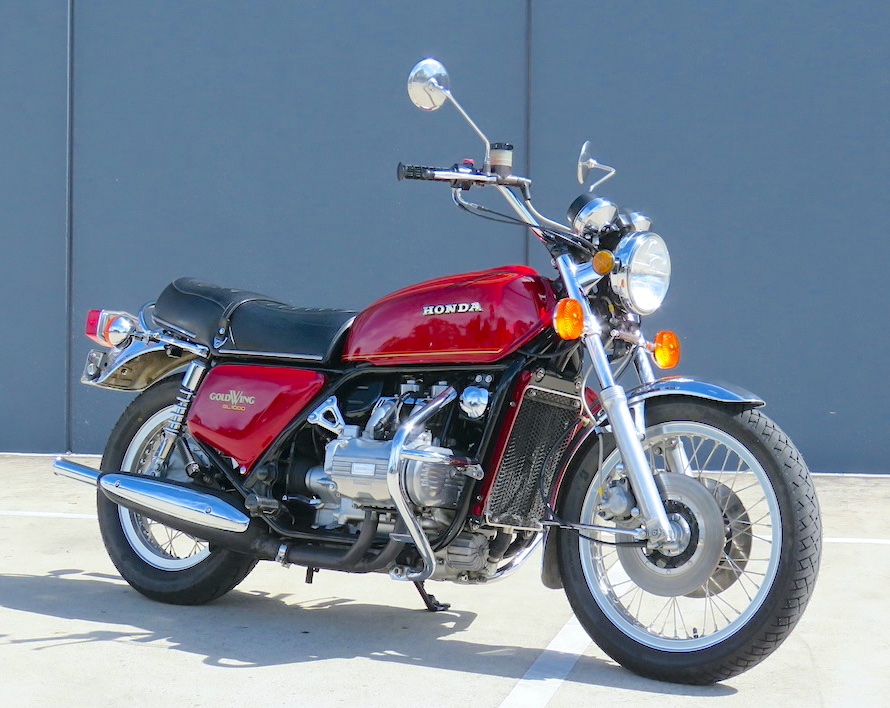Motorcycle Investor mag
Subscribe to our free email news
Badge
me!
Sunday shed wrap
June 8, 2025, by Guy 'Guido' Allen

One of the strange joys
of owning older machinery is, if you're not careful,
you get to know about all sorts of little weird
corners of the industry that supports them. Here's an
example: the tank badges on my 1975 Honda
GL1000 first-year Gold Wing.
It's the third one I
have owned in a relatively short space of time and the
best example I have seen in decades. Which is why I
bought it.
Two owners ago, someone
spent a lot of money restoring it. In fact their
approach was interesting, in that the top cover of the
fuel tank was left in the original paint, because it
was in good if not perfect shape and the owner felt it
should be preserved.
While it's very close to
original – like having the now unobtainable original
exhaust pipes on board – some sensible upgrades were
done. Such as the braided steel brake lines and the
modern Ikon rear shocks. The latter look as near as
dammit to stock and perform far better.
However I noticed the
fuel tank badges had suddenly started to deteriorate.
Close inspection revealed they are replica plastic
items, held on (or not...) with double-sided tape. Of
course I went hunting for the real thing, which is
made of metal, several times the weight, and attached
via clips and pins that run through the 'doors' on the
side of a tank – a much more substantial set-up.
(That's them, the doors, above.)
It turns out the clips
and and grommets used to attach the originals are
still available, but the factory badges are not.
However you can buy more convincing reproductions,
made in Taiwan, that look and feel more like the real
thing. And, hopefully, will last. I'm quietly
wondering if the Taiwan factory may have made the
originals. It's possible, but let's not lose any sleep
over it...
The clips etcetera were
sourced locally through the Honda dealer network,
while the badges came from a mob called 4 into 1 in
California – so they twice had to cross the Pacific
Ocean, which seems a little ridiculous. The badges
cost Au$240 (US$150, GB£120), or about three times the
price of the plastic set.
There is an Australian
maker-supplier, called Badge
Replicas – though we've received no
response to our enquiry.
Here's your quandary for
the day: do you go cheap or expensive? If it's a
cheerful tidy-up of a bike that will be functional and
will look great from a few metres away, but will never
be a top-end unit, then the cheaper option makes
sense.

However I'm mystified
over why the owner or restorer went the cheap route on
this motorcycle. You could say they were unaware of
the alternatives, but the 'doors' on this bike clearly
show a different attachment method which – to anyone
who might have paused and thought about it – would
indicate the stick-on alternative wasn't right.
Here's the thing:
looking at what has been done to this Gold Wing, I'm
confidently guessing the restoration bill would easily
have hit Au$15,000 (US$10,000, GB£7000). That's
ignoring the purchase price of the bike itself. In
that context, why on earth would you buy cheap tank
badges?
I'm putting the decision
down to ignorance or a cock-up, or both. In any case,
whether you buy the $300 badges or the $100 ones is
small beer for a resto.
That aside, the bike has
proved to be a gem, for which I paid Au$16,000
(US$10,000, GB£8000). The price was a little steep at
the time for this model and it has turned out to be a
happy choice.
Thanks to some
well-considered suspension work (front and back) and
new tyres, it handles much better than you might
expect. You can sling it at a turn with enthusiasm and
expect to live! Plus, despite what you may have heard,
these things had loads of performance on tap for the
era and now it's a fun and very capable ride.
See our
Honda GL1000 Gold Wing profile
-------------------------------------------------
Produced by AllMoto abn 61 400 694 722
Privacy: we do not collect cookies or any other data.

Archives
Contact




